Bin insulation for Winter Composting
With the coming of winter most composting processes slow down or stop as a result of the cold weather but there is no reason to stop feeding the compost heap or bin in preparation for an increase in microbial activity when spring eventually puts in an appearance. However you may like to try to keep the composting process working over the winter to increase your yield and as a challenge to show your composting skills.
The use of a commercially available insulated bin, such as the Hotbin or Biolan, will mean that while the composting process may slow a little it should continue during the cold weather.
Alternatively with a little work ordinary bins can be insulated so that they continue the composting process over the winter months. If you continue feeding the heap or bin with the right mixture of greens and browns the rotting process will continue generating its own heat all that is required is that as much as possible of the heat is retained.
One of the keys to success is the size of the bin, or heap, it needs to be at least 1 cubic metre (1.3 cu yards) to provide the critical mass for thermophilic organisms to keep working. Unless insulated to a very high standard a smaller bin or heap is likely to be frozen while one that falls to near freezing will not remain active. The first approach to prolonging the working period is therefore to increase the size of heap to encourage the composting process continues longer into the winter season. It will also be advisable to site the heap or bin so that it is in full sun to take advantage of any external heat.
Covering the compost heap with a tarpaulin or carpet avoids it becoming waterlogged with cold rain and may slow the loss of heat generated but this is not enough to keep the bin working, insulation is necessary to keep the bin functioning during the colder months.
Insulation.
Old carpet, flattened sheets of cardboard or polythene sacks filled with straw or loft lagging ( sealed in a plastic bag to keep it dry) or layers of bubblewrap will help retain the heat if wrapped round a plastic bin or wormery.
Wooden bins can be lined with layers of corrugated cardboard with a layer of polythene (old compost bags?) on the inside where the cardboard would come into contact with the compost. One of the points to be considered when buying or making a wooden bin is whether to opt for solid or slatted sides. The slatted slides offer improved aeration during the summer but are more difficult to insulate during the winter. Bales of straw or hay can provide a quick and easy means of insulation but will some need to be removed to allow waste to be added to keep the composting process working though the winter. An outer wall about six inches bigger than the original sides can be built of wood or blocks round the bin, to provide a space for further insulation to increase heat retention. Wall insulation material is excellent, as is loft insulation but items such as cardboard or bubble wrap can also be used. If a pallet bin is being converted cardboard or other insulating material can be stuffed in the gaps in the pallet to further increase the insulation
The top of the bin must also be insulated. Some sources suggest using a thick layer of bedding, loose straw or leaves, while these will help retain the heat they are not practical if waste food material is to be added to the bin during the winter. A layer of loft or wall insulation sandwiched between wooden boards from pallets or polythene sheeting cut slightly larger than the top of the bin and sealed to keep the insulation dry provides an insulated lid that can be easily removed
Straw Bales
A composter reports that they live off-grid in Colorado at 9,200 foot elevation where the gets very cold cold. (Lows in the n -40s, with negative teens being the high for a few weeks at a time.) He prevented his worm bin freezing by filling it 3/4s full of bedding, (i normally dont go over 25%) and then added lots of food to one side. The bin was then put in the middle of a a base of 9 straw bales with the bin in the middle, and then built a "cabin" around them using about 15 more bales. It worked out great, and in the spring the straw to was used to mulch the garden
Heat generation
While cold weather will slow the compositing process the insulation should maintain the crucial microbial activity inside the heap or bin. The microbial action of the bacteria, fungi, and actinomycetes causing decomposition of the material in the bin will produce heat as a by-product of the chemical process. The bin insulation should mean that this heat is retained.
During the winter fresh waste materials must be added continually to keep the bin at working temperature. It is also recommended that more care is taken to layer the browns and greens. The layers help insulate the heap and retain heat. Shredding or tearing the materials to less than two inches in size has been shown to assist in heating the heap uniformly.
The correct mix of Greens (nitrogen rich) and Browns (carbon sources) is more important during the winter than in the summer months as there will little external heat to assist the composting process. This will be dependant of the heat generated by the process itself. It is suggested that this material needs to be well balanced with C: N ratio between 20:1 and 40:1
Straw, fallen leaves (saved in sacks), shredded newspaper, or sawdust can provide a source of carbon. In addition small amounts of wood ash can are added to increase the calcium, phosphorus, and potassium content of the finished compost.
The main source of nitrogen rich materials during the winter is likely to be kitchen scraps as little will be available from the garden. A good supply of vegetable and fruit peelings is essential. It may be possible to supplement your kitchen waste with some from neighbours. Used Coffee Grounds, provide an additional boost and may be obtainable from a local cafe.
Chickens and rabbit manure also provides a good source of winter nitrogen. Black treacle (Molasses) used at a ratio of 1 part molasses to 20 parts water to soak absorbent material such straw or shredded paper or the manure /animal bedding is a useful addition. As those who make aerated compost tea will be aware black treacle is good source of bacterial nutrients and will help raise the compost temperatures
Moisture in winter composting
Moisture is one of the key factors in the composting process and winter winds and low humidity can dry the compost heap or bin. During warm spells warm water could be added to dampen but not soak the compost if it appears to dry.
However, during wet spells, such as the UK autumn and early winter in 2019, the contents of bins may become very wet. Surprisingly we have found that on the Stokes Wood composting demonstration site in Leicester it was the plastic bins with tight fitting lids that became water logged while the pallet and new Zealand bins, with open tops but with the composting material covered by plastic or carpet had retained the correct moisture level .
Additional browns in the form of shredded paper and a wood chip/leaf mixture were added to dry the composting material and open it up to provide air spaces.
It is suggested that all bins should be monitored during both wet and dry periods and when being left resting as many allotment bins during the winter so that it does not become so wet as to give rise to anaerobic conditions.
Routine aeration and turning the compost during the winter is not recommended by some sources, as this may interfere with the insulation that the careful layering of the bin has produced and let cold air into the material. However others recommend aeration as a means of getting air into the heap which should activate the aerobic micro-organisms and producing heat to maintain the composting process. Rather than using an aeration tool it might be better to empty and refill the bin to ensure a god mix. If a two or three bin system is being used, for what in the spring and summer would be hot composting, when moving the compost from one bin to another the material at the side of the bin should be added towards the middle of the new bin so it composts evenly.
As an alternativeto continuing to use the compost bin Trench composting, in which a trench is dug and filled with kitchen scraps over the winter offers a simple method of composting over the winter months. Although it has fallen out of favour as a composting method, other than for creating a bean trench and for marrows etc, it is still worth considering as a means of composting uncooked kitchen waste.
Bokashi Bin or wormery
One of the indoor methods of composting such as a Bokashi bin or a wormery will reduce the need to venture into the garden during the winter. This of course assumes that the wormery is moved into a shed, garage or outhouse for the winter and not wrapped in insulation and left in the garden.
We have kept wormeries working at Compost Corner at Snibston Discovery Museum during the winter insulating them with loft insulation in polythene bags and bubblewrap. The insulation round the lid needs to be removable so that the Worms can be fed and access should be provided to the tap to enable the Worm Wee to be harvested


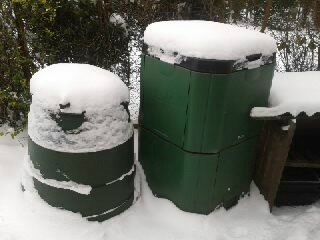
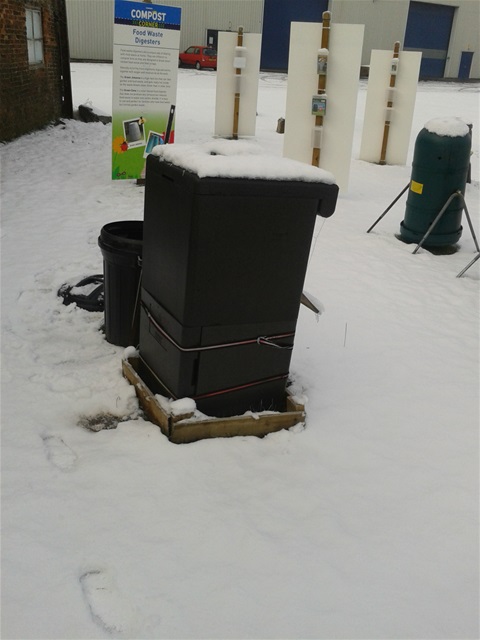

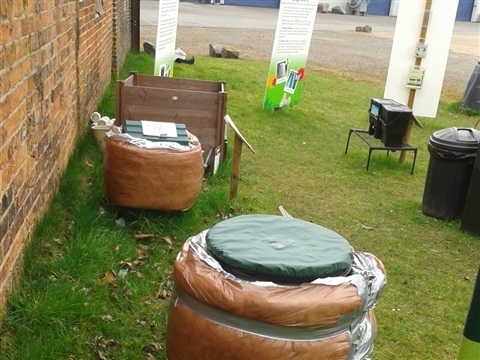
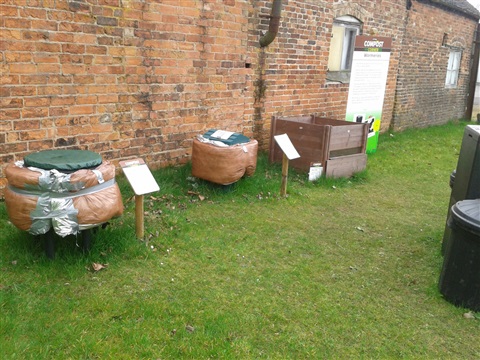
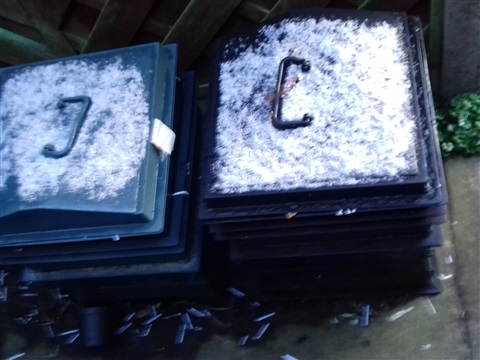
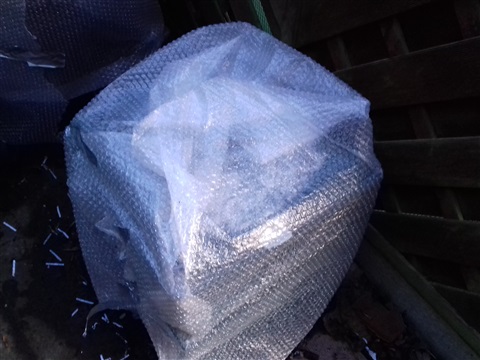
Chloe
We have an Aerobin and also can see an Aerobin in one of your photos, just wondering how is your Aerobin doing during winter time?
Rod
It does slow down but we do not feed it that often in the winter as it is on an allotment demonstration site.They need to be fed ofter to keep them working at their best.
George
With all this wrapping, what stops the compost material from going anaerobic during the winter?
Shrink Wrap
Nice reading, I love your content. This is really a fantastic and informative post. Keep it up.
Drewen Young
Check out ww.hotdamncomposter.com. We make mini in-vessel composting bins out of recycled chest freezers. Less than $20 to repurpose.